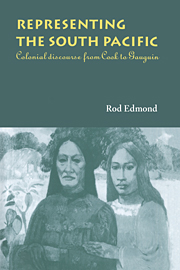Book contents
- Frontmatter
- Contents
- List of illustrations
- Acknowledgements
- 1 Introduction
- 2 Killing the god: the afterlife of Cook's death
- 3 Mutineers and beachcombers
- 4 Missionary endeavours
- 5 Trade and adventure
- 6 Taking up with kanakas: Robert Louis Stevenson and the Pacific
- 7 Skin and bones: Jack London's diseased Pacific
- 8 The French Pacific
- 9 Epilogue
- Notes
- Index
6 - Taking up with kanakas: Robert Louis Stevenson and the Pacific
Published online by Cambridge University Press: 31 October 2009
- Frontmatter
- Contents
- List of illustrations
- Acknowledgements
- 1 Introduction
- 2 Killing the god: the afterlife of Cook's death
- 3 Mutineers and beachcombers
- 4 Missionary endeavours
- 5 Trade and adventure
- 6 Taking up with kanakas: Robert Louis Stevenson and the Pacific
- 7 Skin and bones: Jack London's diseased Pacific
- 8 The French Pacific
- 9 Epilogue
- Notes
- Index
Summary
The Coral Island was a favourite boyhood book of Stevenson's, and at the age of thirteen he wrote a Pacific adventure story in imitation of Ballantyne's tale. Several years later he approached Ballantyne outside a church in Edinburgh and invited him home to dinner. The introductory verses to Treasure Island celebrated his early pleasure in ‘Kingston … [and] Ballantyne the brave’, and when Ballantyne died in 1894 Stevenson wrote from Samoa in support of a memorial fund, the letter being published in many leading daily papers. His early Ballantyne-inspired enthusiasm for the Pacific had been furthered by a New Zealand visitor to the Stevenson home in 1875 whose account of the Samoan islands excited him. He began a Utopian novel, The Hair Trunk or The Ideal Commonwealth, in which a group of friends turn their backs on civilization for the ‘ideal climate, ideal inhabitants, and ideal products’ of Samoa. During his first visit to San Francisco in 1879–80 Stevenson met the Pacific traveller-writer Charles Warren Stoddard, who fascinated him with accounts of his travels and introduced him to the work of Melville. In 1888 he also met Mark Twain, and later that year with his wife Fanny and their extended families he sailed out of San Francisco on the Casco for the Marquesas.
Stevenson's own Pacific writing was the product of complex transactions between an already extensively textualized Pacific and his own distinctive experience as a traveller-writer who was to become a settler.
- Type
- Chapter
- Information
- Representing the South PacificColonial Discourse from Cook to Gauguin, pp. 160 - 193Publisher: Cambridge University PressPrint publication year: 1997
- 1
- Cited by

